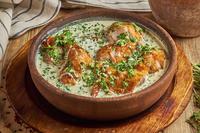Mchadi, a traditional Georgian cornbread, embodies the rich culinary heritage of Georgia. Made from a simple mixture of cornmeal, water, and salt, this bread is typically fried in oil until it achieves a golden-brown perfection. Often served warm alongside kidney beans and cheese, mchadi is a beloved staple in Georgian cuisine. This article delves into the history, regional variations, and cultural significance of mchadi, offering insights into why this humble bread is much more than just a food item in Georgia's gastronomic landscape.
The Historical Journey of Corn and Mchadi in Georgia
The story of mchadi in Georgia is deeply intertwined with the history of maize, or corn, in the region. Dr. Michael Denner, a noted scholar, highlights the fascinating journey of corn from South America to Georgia, possibly as early as the sixteenth century. This introduction of corn, possibly through China or via the Persian empire, brought a significant change to Georgian agriculture and cuisine. A geographical divide within Georgia demarcates the "corn belt" from the "wheat belt," with the western regions favoring corn cultivation due to their hot and rainy climate. Here, mchadi, often cooked in a traditional ketsi or a cast-iron skillet, reigns supreme. Contrary to popular belief, authentic mchadi in Georgia often includes additions like salt, sugar, and baking soda, marking a departure from the traditional cornmeal and water recipe.
Mchadi, for many Georgians, is more than just bread; it's a reminder of home and heritage. Personal anecdotes reveal that preferences for mchadi can vary greatly, from the simplest form made with just cornmeal and water to more modern versions incorporating milk and baking soda. The bread's versatility in pairing with diverse foods, from cheese to smoked fish, highlights its integral role in Georgian dining. The taste of mchadi, described as the "perfect foil" for salty and spicy flavors, often invokes nostalgia among Georgians living abroad, as it represents a taste of their motherland.
A Look at Mchadi's Ingredients and Cooking Techniques
While the full recipe for mchadi is vast, a brief overview of its ingredients and preparation methods offers valuable insights. Key ingredients include finely-ground white cornmeal, fresh water, milk, sea salt, sugar, and baking soda, with vegetable oil, preferably sunflower oil, for frying. The preparation of mchadi involves warming the liquids, combining the dry ingredients, and then mixing them with the liquids to form a dough. The dough's consistency is crucial; it should be soft, malleable, but not sticky or runny. Shaped into oval cakes, the mchadi is then fried on a skillet or griddle until both sides achieve a light brown color. This process emphasizes the importance of cooking techniques and ingredient proportions in achieving the perfect mchadi.
Mchadi's Place in Georgian Culture and Cuisine
Mchadi's cultural significance in Georgia extends beyond its taste and ingredients. This cornbread is a symbol of Georgia's agricultural history, its culinary diversity, and its connection to other cultures and nations, like Armenia and Azerbaijan. Georgian cuisine, with mchadi as a central element, reflects the country's multiethnic composition and the interplay of various cultural influences. When served with traditional Georgian dishes or Armenian tan, mchadi exemplifies the fusion of flavors and traditions that make Georgian cuisine unique. This bread, simple in its composition, carries with it the stories and tastes of a nation, making it an essential experience for travelers exploring Georgia's culinary landscape.

 Georgian Khinkali
Georgian Khinkali
 Pairing Wine & Cuisine
Pairing Wine & Cuisine
 A Family Feast
A Family Feast
 Supra Sensations
Supra Sensations
 Georgian Street Food
Georgian Street Food
 Georgian Khachapuri
Georgian Khachapuri
 Shkmeruli
Shkmeruli
 Georgian Lobio
Georgian Lobio
 Georgian Kharcho
Georgian Kharcho
 Top 7 Authentic Georgian Khachapuri Recipes
Top 7 Authentic Georgian Khachapuri Recipes
 Georgian Salad
Georgian Salad
 Badrijani
Badrijani
 Ajapsandali
Ajapsandali
 Ojakhuri
Ojakhuri
 Chashushuli
Chashushuli
 Bazhe Sauce
Bazhe Sauce
 Satsivi
Satsivi
 Tkemali
Tkemali
 Chikhirtma
Chikhirtma
 Khashlama
Khashlama
 Mtsvadi
Mtsvadi
 Kupati
Kupati
 Tolma
Tolma
 Chicken Tabaka
Chicken Tabaka
 Chakhokhbili
Chakhokhbili
 Nazuki
Nazuki
 Georgian Bread
Georgian Bread
 Chvishtari
Chvishtari
 Satsebeli
Satsebeli
 Jonjoli
Jonjoli
 Chanakhi
Chanakhi
 Chakapuli
Chakapuli
 Kuchmachi
Kuchmachi
 Shila Plavi
Shila Plavi
 Soko Ketse
Soko Ketse
 Pkhali
Pkhali
 Ghomi
Ghomi
 Elarji
Elarji




